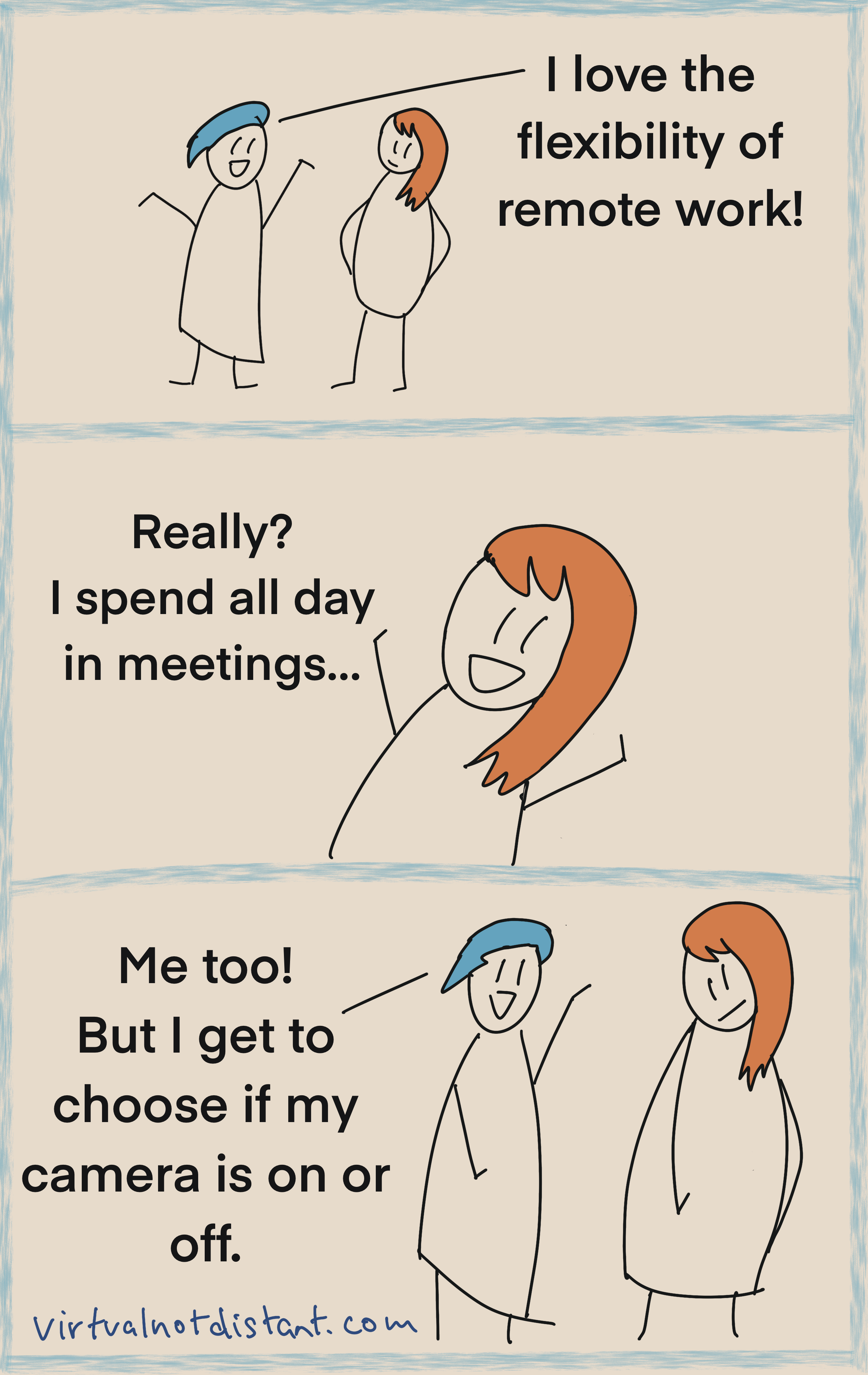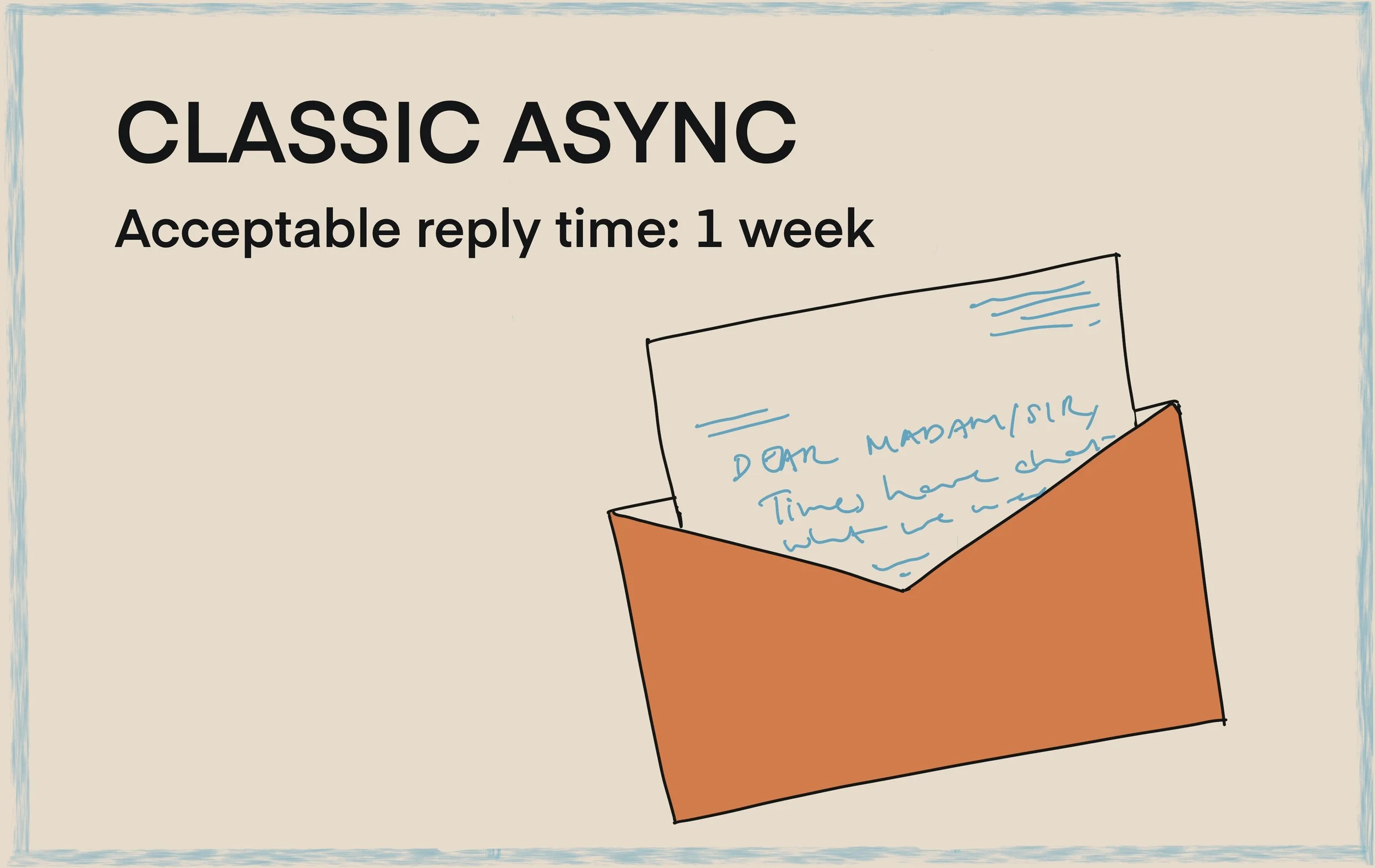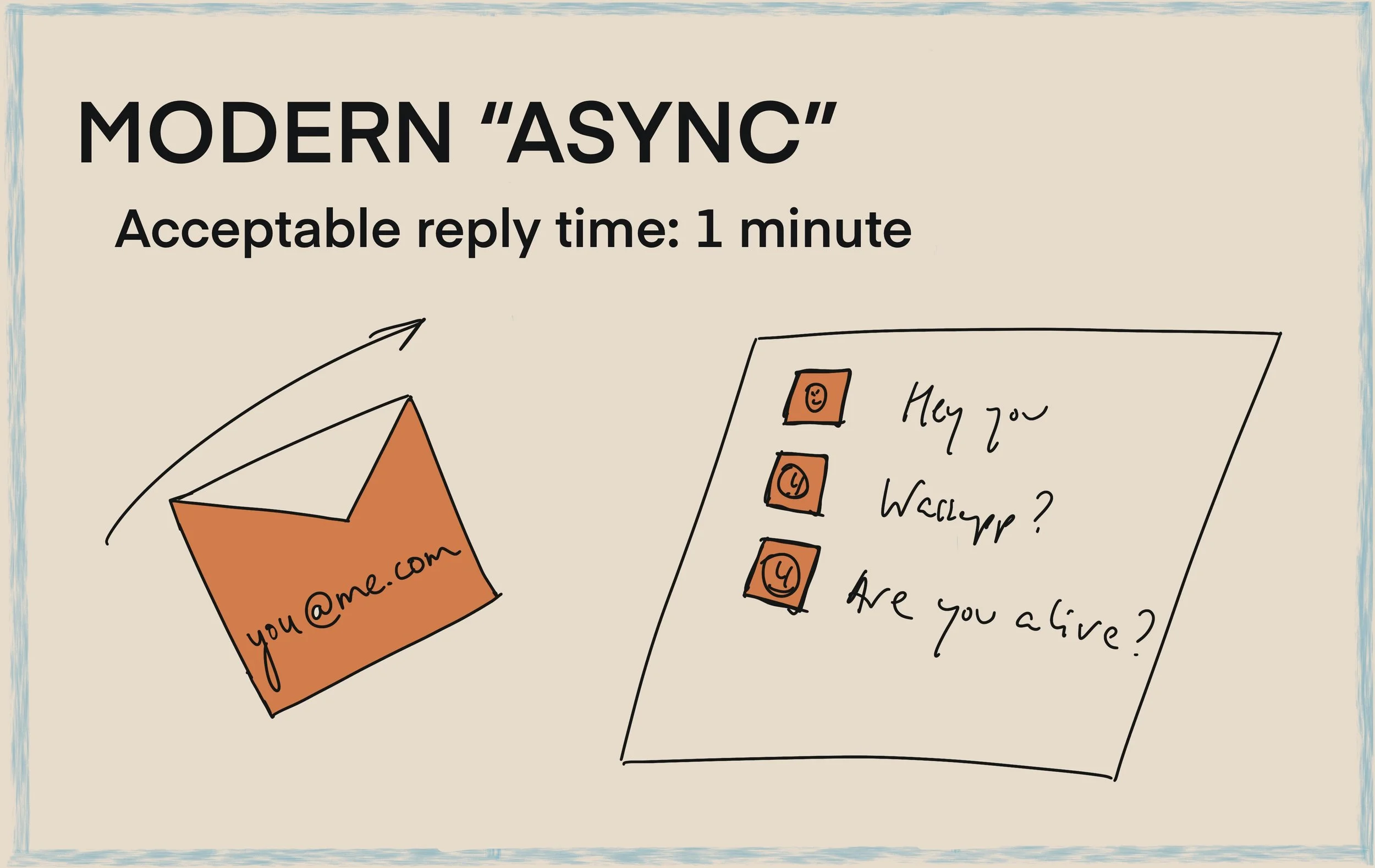Foundations of Online Collaboration: Adopting an Asynchronous Mindset
Remote work based on having meetings back to back is not sustainable. Asynchronous communication is an integral part of online collaboration, and there are many benefits to adopting an asynchronous mindset. Find them in this post, written by Pilar and Simon, and let us know what you think of the cartoon!
Many people have now experienced remote work. They like it. They enjoy the flexibility of being able to plan their day away from others. They enjoy choosing the location in which they work best. But teams are still struggling with what seems a utopian concept: online collaboration.
For many, many years, “collaboration” has been synonymous with “meetings”. Meeting overload was already an issue in some organisations before the pandemic. Online meeting overload has now become an issue for most teams.
We’re running the risk of “remote work” becoming synonymous with “screen fatigue”, and for the conversation about how to make hybrid teamwork work to be limited to how to run a hybrid meeting.
But to make remote work (and it’s subset of hybrid work) productive, comfortable and joyful we need to let go of meetings as the main tool for communication, connection and collaboration. We need to embrace asynchronous communication.
What is asynchronous communication?
Any kind of communication where I send out my message but don’t receive an immediate reply from you is asynchronous communication. When a team fully incorporates asynchronous communication into their practice, team members don’t expect replies or comments to their messages immediately.
Asynchronous communication works best when we agree on our reply times, and when it’s incorporated into workflows where team members don’t need to communicate every hour, or even every day.
Examples of asynchronous communication
A marketing team using a planning board, (eg. Trello), to keep track of the content they’re putting out. In their own time, team members mark their progress and ask relevant task-related questions, on the board.
Members of a global team, which have very little overlapping work time, commit to uploading a 90 second video once a week with personal updates, to stay connected in the team.
A leadership team keeps an online notebook (eg OneNote), where they reflect every two weeks on a challenge they’ve come across.
Two team members work on a client proposal online (eg Google Docs) using the Comments section to build on each other’s ideas and give feedback
Members of a team check in once a week to share their achievements and accomplishments in a Slack channel.
The Benefits of Adopting an Asynchronous Mindset
Let’s face it.
The most difficult part of adopting asynchronous communication is adopting an asynchronous mindset. This means thinking that many of the things we’re used to doing in real-time, can also be done asynchronously.
One you make this shift, the benefits to incorporating asynchronous practices into your team collaboration become clear.
Asynchronous communication increases our sense of autonomy.
Autonomy is an important part of intrinsic motivation.
Asynchronous communication allows you to choose when to communicate with others. It helps you feel like you don’t need to be available all the time to others and helps you design your work day in a way that suits your personality, tasks and lifestyle best.It prompts team members to organise their time.
Working with an asynchronous mindset means that you can take charge of your time. As a team you need to work in a structured way. This means that you need to plan what you’re going to work on and when, so that you can communicate your availability. Working in this way can prompt some of the more disorganised members to structure their work days.You reduce the time needed for meetings and you make those meetings more meaningful and productive.
Traditionally, meetings have been used for quick exchanges of information, as well as for meaty conversations. Asynchronous communication can replace those meetings focusing on exchange of information. I’d even go as far as to say that in most cases, asynchronous communication can help us exchange information more clearly than verbally.
You can then use meetings for complex conversations that are difficult to have asynchronously. Meetings can focus on reconnecting as human beings, without overloading your schedule.You can assign blocks of time to tasks needing your full attention.
Once you have agreed with your team when to expect a reply to your messages and how to get hold of you in case of an emergency, you can turn off all notifications and get down to some solid, focused work. You can block time in your diary to communicate with your team.You can take your time replying - and that can help reflection and creativity.
Some people are very quick at formulating their thoughts and communicating them; others need more time to find the right words, or pick out the thoughts that are relevant.
All creative processes benefit from letting the subconscious mull over a question, a thought, a suggestion… When you commit to working asynchronously, you accept that ideas need time to emerge and develop, and you start to incorporate a slower pace to your creative processes.You get help faster.
Paradoxically, adopting an asynchronous mindset can help people find answers to their questions fast, without waiting for someone to be available to answer them. Most of the information and interactions held in the team are recorded and searchable, so team members can find information without waiting for someone to point them to it.You create a “team memory”
A lot of learning and idea generation goes on day by day. But if all of these thoughts are lost as soon as they are shared, a team loses a lot of information that can be useful later on. Asynchronous processes allow people to share their learnings as they happen, and where they ask for help or information can produce a “bank” of team thoughts or a “team memory”.
Part of the onboarding process for someone joining a remote team is understanding the team’s ways of working and culture. Asynchronous conversations produce a record of how people speak to each other, what they value, how they like to express themselves. In teams where asynchronous communication is the default, people also share their thoughts online. For someone new to the team, this can be invaluable.You can work with people with diverse schedules and in different timezones.
Our hearts sink every time we hear that someone needs to get up at 5am to be in a team meeting, or that they have to stay up till 8 o’clock at night (unless that’s how they choose to work). Working with people across the world should be joyful. If your team members are located across the world, embrace asynchronous communication so that people can feel connected and involved, regardless of their sleep schedule.
Beyond “Meeting-centric”
There is no doubt that real-time conversations are crucial to help your team members stay aligned and connected. An asynchronous mindset will help you think about how to integrate them into your asynchronous workflow - rather than thinking about how your asynchronous communication can support your meetings.
It’s a big shift in mindset, but it will help you design ways of working you can sustain.
And if you need any help, right now, check out the Additional Resources on the page which has details of our self-paced course Let’s Meet Less! Adopting Asynchronous Communication.
Or if you have already embraced the asynchronous mindset, and are interested in the course when it comes up, drop Pilar a line.



